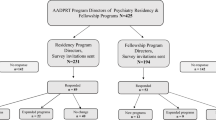Abstract
Objectives
Canadian residency training programs (RTP) have a program director (PD) and a residency program committee (RPC) overseeing program administration. Limited guidance is available about the ideal administrative structure of an RTP. This article describes administrative load in Canadian RTPs, presents a novel approach to delegating core administrative tasks within the RTP, and provides initial impressions of positive outcomes following implementation of this new system.
Method
All PDs of Canadian psychiatry RTPs were surveyed with respect to their program administrative structure, involvement of their training committees, and the percentage of work done by the PD compared to the rest of the RPC. At Queen’s University, program domains were created representing well-defined areas within the RTP, each being assigned a program domain manager.
Results
RPCs were mainly consultative, averaging 14 members. The average PD: RPC workload ratio was 80:20. Three programs allowed for 50% of the program director’s time to be dedicated to serving that position, with an average time dedication of 37%.
Conclusion
The position of PD in psychiatry requires an average of 37% of the program director’s time, while carrying an estimated 82% of the administrative workload. The program domain manager administration system implemented at Queen’s University enabled the PD to be simultaneously up to date with all major areas of the program while experiencing a substantial decrease in the administrative workload, achieved through increased work contribution of the RPC. This system encourages closer involvement of RPC members in decision making and development of their program domains, allowing the PD more time for developing implementing and overseeing innovations across the RTP spectrum. Furthermore, it has led to a PD: RPC workload shift from a ratio of 90:10 to one of about 60:40. Essentially, this resulted in a more efficient and adaptable RPC and RTP.
Similar content being viewed by others
References
Beasley BW, Kern DE, Kolodner K: Job turnover and its correlates among residency program directors in internal medicine: a three-year cohort study. Acad Med 2001; 76: 1127–1135
Beresin EV: The administration of residency training programs. Child Adolesc Psychiatr Clin N Am 2002; 11: 67–89, vi
Durning SJ, Cation LJ, Ender PT, et al: A resident research director can improve internal medicine resident research productivity. Teach Learn Med 2004; 16: 279–283
Lovejoy FH Jr, First LR: Ten years of a residency training committee. Acad Med 1991; 66: 602–603
Pugno PA, Dornfest FD, Kahn NB Jr, et al: The National Institute for Program Director Development: a school for program directors. J Am Board Fam Pract 2002; 15: 209–213
Royal College of Physicians and Surgeons of Canada: Accreditation of Residency Programs: General Standards of Accreditation to All Residency Programs. Standard B 1: Administrative Structure, 1998
Wolfsthal SDM, Beasley BWM, Kopelman RM, et al: Benchmarks of Support in Internal Medicine Residency Training Programs. Acad Med 2002; 77: 50–56
Author information
Authors and Affiliations
Corresponding author
Rights and permissions
About this article
Cite this article
van Zyl, L.T., Finch, S.J., Davidson, P.R. et al. Administrative Restructuring of a Residency Training Program for Improved Efficiency and Output. Acad Psychiatry 29, 464–470 (2005). https://doi.org/10.1176/appi.ap.29.5.464
Received:
Revised:
Accepted:
Published:
Issue Date:
DOI: https://doi.org/10.1176/appi.ap.29.5.464



